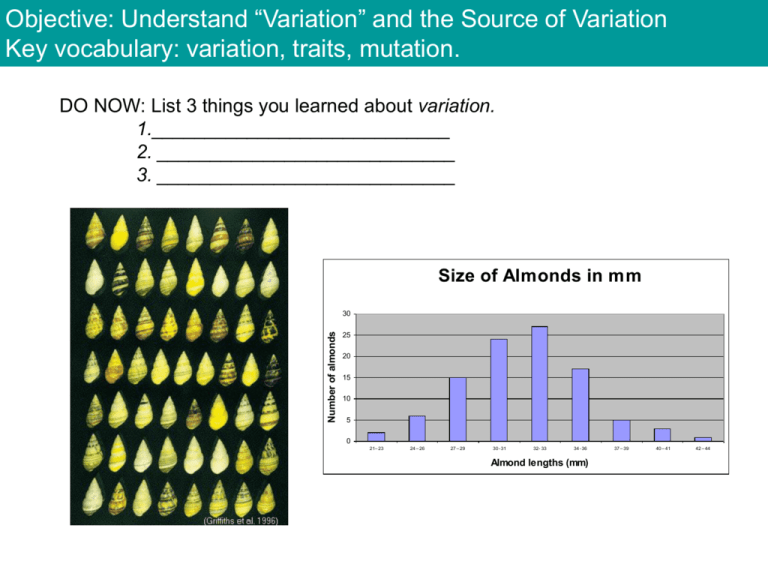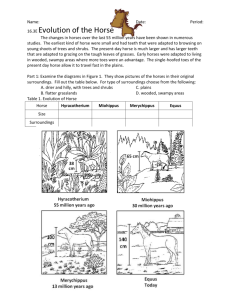Evolution
advertisement

Objective: Understand “Variation” and the Source of Variation Key vocabulary: variation, traits, mutation. DO NOW: List 3 things you learned about variation. 1.____________________________ 2. ____________________________ 3. ____________________________ Size of Almonds in mm Number of almonds 30 25 20 15 10 5 0 21– 23 24 – 26 27 – 29 30 -31 32- 33 34 -36 Almond lengths (mm) 37 – 39 40 – 41 42 – 44 Objective: Understand Evolution as Change of a Population Over Time Key words: fossils, adaptation, evolution, natural selection Most organisms live, die and decompose. They leave no traces of having lived. Under certain conditions, an organism’s remains or tracks may be preserved as a fossil. Fossils give clues about how an organism looked and where it lived. They are often used by scientists as evidence of change. A fossil is any remains of a once-living thing. Fossils may only be the outline of some plant, animal, or other organism that is preserved in rock. Sometimes, entire skeletons of animals that lived millions of years ago are found. DO NOW: • What is a fossil? A fossil is any remains of a once-living thing • Give 2 examples of fossils. • the outline of plants or animals that is preserved in rock • entire skeletons of animals that lived millions of years ago Objective: Understand Evolution as Change of a Population Over Time Key words: fossils, adaptation, evolution, natural selection How Do fossils Show Change? Objective: Understand Evolution as Change of a Population Over Time Key words: fossils, adaptation, evolution, natural selection Horse Hyracotherium Miohippus Age 55 million Years ago 30 million Years ago Size 38 cm 65 cm Type of surroundings Forest, wooded, swampy areas Taiga Forest with trees and shrubs Merychippus 13 million Years ago 100 Prairie scattered trees, shoots of shrubs abundant grass Equus Today 140 cm Plain grasslands Objective: Understand Evolution as Change of a Population Over Time Key words: fossils, adaptation, evolution, natural selection 2. Look for and color the following kind of bones for each fossil hors. a. Color the toe bones red. These are marked for you with an x. b. Color the foot bones blue. These are marked for you with a y. c. Color the ankle bones green. These are marked with a w. d. Color the heel bones yellow. These are marked with a z. Objective: Understand Evolution as Change of a Population Over Time Key words: fossils, adaptation, evolution, natural selection Kind of Horse Hyracotherium Miohippus Merychippus Equus Number of toes 4 3 3 1 Number of toe bones 12 9 9 3 Number of foot bones 4 3 3 3 Number of ankle bones 7 6 4 4 Number of heel bones 1 1 1 1 Total number of foot bones 24 19 17 11 14 18 21 38 16 17 20 39 Length of foot (measure inset diagrams in mm) Height of teeth (mm) Objective: Understand Evolution as the Change of a Population Over Time Key words: fossils, adaptation, evolution, natural selection 1. What changes occurred in the surroundings of horses from Hyracotherium to Equus? The environment changed from rainforest to grassland. Less plants, more open space. 2. What change occurred in the size of the horse from Hyracotherium to Equus? The earliest horses were small. The horse size has increased over time. 3. How is called the change of the horse population over time? Evolution 4. How do you explain the changes in the size of the horses? Horses adapted to environmental changes: As there is less vegetation in the environment, horses increased in size. Objective: Understand Evolution as the Change of a Population Over Time Key words: fossils, adaptation, evolution, natural selection 5. As the surroundings changed, what happened to the teeth of the horse? As the surrounding changed, the teeth of the horse became larger and longer. The present-day horse has larger teeth than earliest horses. 6. Describe the overall changes in foot length, number of toes, and size of toes in the horse over time. Foot length increased, number of toes reduced from 4 to 1 toe, size of toes became larger in the horse over time Objective: Understand Evolution as Change of a Population Over Time Key words: fossils, adaptation, evolution, natural selection 7. How do you call the changes in foot length, number of toes, and size of toes in the horse over time? Evolution 8. How would natural selection have caused changes in the size, feet, and teeth of the horse? Horse Teeth The earliest horses had teeth that were adapted to browsing on young shoots of trees and shrubs. The present-day horse is much larger and has larger teeth that are adapted to grazing on the tough leaves of grasses. Size and Number of Toes Early horses were adapted to living in wooded, swampy areas where more toes where more toes were an advantage. The single-hoofed toes of the present-day horse allow it to travel fast in the plains.








